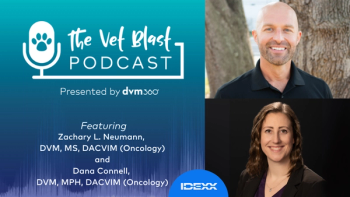
Cancer: Cases likely will rise in aging animals
Cancer is a leading cause of death in pet dogs and cats. It is estimated that almost 50 percent of geriatric dogs and 33 percent of cats will die of cancer. As the pet population in the United States continues to age, cancer in pet animals is expected to become an even more significant problem in the field of animal health.
Editor's Note: This article was written in collaboration with Dr. Chand Khanna, DVM, PhD, Dipl. ACVIM (oncology) of the Animal Cancer Institute and Friendship Hospital For Animals in Washington, D.C.
Cancer is a leading cause of death in pet dogs and cats. It is estimated that almost 50 percent of geriatric dogs and 33 percent of cats will die of cancer. As the pet population in the United States continues to age, cancer in pet animals is expected to become an even more significant problem in the field of animal health.
Microscopic findings support role of the immune system in the detection and killing of cancer cells. This transmission electron microscopic image illustrates an active tumor cell directing intracytoplasmic granules toward a large tumor cell.
The need for new treatments that are more effective and less toxic is widely recognized. Our understanding of the biology of cancer has expanded in recent years and now is shedding light on novel treatment strategies for this problem.
Tumor biology and metastasis
Cancer is strictly defined as an uncontrolled growth (or proliferation) of cells resulting in an abnormal accumulation of cells in a particular region of the body. This process is the result of aberrant activation or expression of the genes within a cell. As such, cancer is a genetic disease
.
The types and numbers of genetic changes that are acquired by a cancer cell, in many ways, define a specific cancer; however, the result of these genetic changes is the acquisition of a common set of features of cancer (Hanahan and Weinberg model):
- Self-sufficiency in growth signals
- Insensitivity to growth inhibitory signals
- Evading programmed cell death (apoptosis)
- Unlimited replication potential
- Sustained new blood vessel formation (angiogenesis)
- Tissue invasion and metastasis.
Each of these six processes (hallmarks of cancer) distinguishes a normal cell from a cancer cell.
The spread of cancer from a primary tumor to distant sites represents the most significant problem in the field of cancer. Pets that present with metastatic disease, or those who develop metastases after successful management of the primary tumor, carry a universally grave prognosis. As such, advances in the field of cancer treatment are focused on the problem of preventing or managing cancer metastasis.
The process of metastasis results from a series of complex steps. First, cells must leave the site of the primary tumor, pass through the tumor basement membrane, and then enter the circulation (extravasation). Circulating tumor cells must be capable of evading immune recognition and physical stress with an ultimate goal of arresting at distant organs.
Antiangiogenic inhibitory peptides of thrombospondin-1 (TSP-1) is resulted in the regression of an invasive rostral maxillary squamous cell carcinoma in a 10-year-old Rottweiller cross. Loss of the left maxillary canine tooth was noted at the time of presentation (open arrow head). Progression of the mass was noted through the first 60 days of therapy with daily subcutaneous thrombospondin-1 inhibitory peptides, with evidence of hemorrhage from the tumor site (open arrow). Complete regression of the measurable mass occurred after 90 days of treatment. Incisional biopsy at the previous tumor site conducted at day 270 revealed microscopic evidence of squamous cell carcinoma in spite of the complete regression of the measurable lesion. The dog remains on daily TSP-1 therapy, asymptomatic, free of measurable tumor more than three years after the initial diagnosis.
At that distant site, the cell must leave the circulation and survive in the hostile micro-environment of the foreign tissue site. This distant site might be the eventual target organ for metastasis or might be a temporary site. In either case, the cancer cell is thought to lie dormant for a protracted period of time before moving to its final location. Following dormancy, the cells receive signals to proliferate, create new blood vessels (angiogenesis) or co-opt existing blood vessels, and then successfully grow into measurable metastatic lesions. It is likely that further progression is associated with the repetition of this process and the development of metastases from metastases.
From this improved understanding of the building blocks of cancer and the steps associated with cancer metastasis has come an opportunity for the development of new treatments for cancer. In the near future, these biology-based cancer treatments, discussed herein, will change the way in which we treat cancer and change the definition of the problem of cancer in pet animals.
Novel treatment opportunities
Conventional treatment options, such as surgery, chemotherapy and radiation therapy, are expected to be an integral part of veterinary oncology. Through our improved understanding of the biology of cancer, novel treatment approaches are being developed actively, and in some cases, they now are available commercially. The sections below outline specific areas of oncology research and their potential to add value to the management of the veterinary cancer patient. The following paragraphs outline specific treatment options in development or use in pet animals that are directed against processes important in the progression of cancer.
Targeting cancer cell invasion
The process of dissolving the extracellular matrix is essential for cancer cells as they initiate the metastatic process within the primary tumor site and when the cell attempts to leave the circulation at distant metastatic sites. This process of invasion is regulated by a series of enzymes, including matrix metalloproteinases (MMP). Many commonly used veterinary drugs inhibit MMP activity (i.e. doxycycline); however, agents specifically designed to antagonize these enzymes are not, and likely will not , become available. Most clinical trials using MMP inhibitors have not been successful in human patients. A failure to define optimally effective doses and treatment schedules, and unexpected toxicities for these MMP inhibitors may in part explain their failures. The use of doxycycline in the management of cancer remains largely anecdotal. In general, doxycyline is considered to be a well-tolerated agent. For dogs with few other options, the use of doxycycline may be considered if palliative support for cancer-related pain and cachexia can be provided to patients.
Antiangiogenic inhibitory peptides of thrombospondin-1 (TSP-1) resulted in the complete regression of pulmonary metastases in a dog with metastatic synovial cell carcinoma. After successful control of a forelimb synovial cell sarcoma, metastases to the lungs were noted on routine screening of thoracic radiographs (white arrows). Therapy with single agent TSP-1 inhibitory peptides was initiated subcutaneously once daily. Through 30 days of therapy, some metastatic nodules appeared smaller while others appeared larger. Through 60 days of therapy, a complete regression of pulmonary metastasis was documented. Metastases subsequently developed to the tarsus and spine with no evidence of recurrent disease to the lung.
Harnessing the immune system
The belief that the immune system may play a role in the treatment of cancer has been held for more than 100 years. Coley, a surgeon in the early 1900s, observed the spontaneous regression of large ovarian tumors in women following bacterial sepsis. His belief that the fever associated with sepsis was responsible for regression of the tumors led him to administer mixtures of bacteria to patients in the hopes of recreating fever and resultant tumor regression. These bacterial mixtures, referred to as Coley's toxins, were the first documented attempts at cancer immunotherapy. Since the days of Coley, considerable progress in our understanding of the immune response (and lack of immune response) against cancer has emerged. This understanding may be summarized in the following generalizations:
- Some cancers are considered highly sensitive to immune recognition and destruction (immunogenic), while other cancers illicit little to no immune response.
- The determinants for immune-medicated recognition of cancer are specific to each cancer type.
- Cancers evade immune recognition by many different mechanisms.
- The cell-mediated immune response is important in generating cancer immune recognition and destruction.
- Cancer immunotherapy is likely to be most effective against small-tumor burden.
This understanding has led to several promising strategies that use the immune system to first detect and then destroy cancer cells. Approaches to immunotherapy include the following:
Non-specific immunotherapy: Bacterial agents (e.g. BCG, Corynebacterium parvum, Salmonella typhimurium), natural products (Acemannan), synthetic compounds (Muramyl tripeptide), chemical agents and others are used to stimulate an immune response. This approach is similar to that of Coley and is referred to as non-specific because the target for immune recognition in cancer is not known. The most extensively studied form of non-specific immunotherapy in veterinary oncology is muramyl tripeptide (MTP).
In randomized, controlled and placebo-blinded trials, MacEwen et al have demonstrated the activity of MTP against canine osteosarcoma and canine hemangiosarcoma. Treatment of dogs with osteosarcoma or hemangiosarcoma using MTP plus chemotherapy resulted in significantly longer survival times compared to chemotherapy alone. There has been a renewed commercial interest in the development of MTP by IDM Inc., which is considering the development of MTP for the human cancer market.
Specific immunotherapy attempts to generate a specific immune response against a known or unknown tumor antigen (target). A tumor vaccine is the most common form of specific immunotherapy. Our understanding of the immune response against cancer suggests that the most effective tumor vaccines will stimulate cell-mediated responses against cancer. Clinical trials using a number of vaccination approaches are currently ongoing across the country for dogs with melanoma, osteosarcoma and hemangiosarcoma. More information about these clinical trials can be found at
Adoptive immunotherapy refers to the administration of parts of the immune system to a patient. Monoclonal antibodies raised against cancers represent adoptive humoral immunotherapy. Advances in the design of monoclonal antibodies to prevent immune reactions against the antibody and to improve antigen recognition have raised the potential value of this type of therapy. The landmark approval of Herceptin®, an antibody that binds the Her2/neu gene product to treat breast cancer in women, is evidence of the progress that has been made in this field. Since the approval of Herceptin, a series of antibody-based therapies have become available for the treatment of cancer in human patients (e.g., Avastin, Erbitux, Rituxin). These treatments have received considerable press, and as such, interest from pet owners. Humanized mono-clonal antibodies are not likely to have wide application in the treatment of canine or feline cancers because the development of neutralizing antibodies by dogs against these human proteins is likely to occur. It is likely that the next generation of agents based on adoptive transfer, developed for the human cancer market, will include peptide antibodies. It is likely that these peptide antibodies will be useful as both human and veterinary drugs.
Cytokine immunotherapy refers to the administration of products of the immune system (cytokines) to stimulate or direct anti-tumor immune responses. Cytokines are released by leukocytes and function in the activation and regulation of the immune response. Cytokines, such as interleukin-2 (IL-2), have been used to induce significant anti-tumor immune responses and objective tumor responses in dogs with osteosarcoma (Khanna et al, Cancer 1997). Interleukin-2 is commercially available through most large drug distributors. Anecdotal reports suggest that a small number of dogs with pulmonary metastasis from appendicular osteosarcoma may achieve complete regression of metastases after the inhalation free IL-2. It is not likely that cytokine therapy will become a single cancer treatment. Instead, it is more likely that it will become part of another immunotherapeutic approach (i.e. used as a cancer vaccine adjuvant).
Targeting cancer cell-specific signals
A number of small molecules that inhibit signal transduction from growth-factor receptors have been developed as cancer agents. The most widely recognized is the tyrosine kinase inhibitor Gleevec (Imatinib). Many of these agents may have a role in treating both the primary tumor and distant metastases through the disruption of critical survival signals provided by these growth-factor receptors. In work from London et al, a small molecule inhibitor (SU11654) of the split tyrosine kinase receptor family was found to be active in a number of canine cancers, including mast-cell tumors, metastatic sarcoma and mammary carcinoma. The split tyrosine kinase receptors that are inhibited by SU11654 have a diversity of biological effects. As such, the effect of their inhibition may not be limited to preventing survival. As a class, small molecular inhibitors of tyrosine kinase receptors represent one of the most promising types of novel therapies for cancer and cancer metastases. Clinical trials using small molecule inhibitors are underway at several veterinary referral centers and veterinary teaching hospitals across the country.
Targeting cancer-associated blood vessels: Angiogenesis describes the generation or recruitment of new blood vessels. It appears that new blood vessel development is essential for tumor cells to grow and metastasize. The new blood vessels may be created by the tumor or may be recruited from the surrounding normal tissues. If new blood vessel formation or recruitment can be inhibited, a tumor cannot progress and may cause established tumors to regress. Therapies that are directed against blood vessels and not tumor cells are likely to be active against a wide spectrum of cancers. Biological differences between tumor-associated endothelial cells and normal endothelial cells have become apparent. This has led to several novel therapeutic agents that either prevent new blood vessel formation or survival (antiangiogenic agents) or specifically target existing tumor-associated blood vessels (vascular targeting agents). Recent studies using antiangiogenic peptides of thrombospondin-I (TSP-I) have demonstrated surprising objective regressions of primary and metastatic cancers in dogs with a variety of histologies and have significantly extended remission duration in dogs with lymphoma when combined with chemotherapy (demonstrated in a randomized controlled trial). Trials with TSP-I peptides in dogs are underway at several sites across the United States (
Progress that has been made in our understanding of the basic biology of cancer has uncovered several opportunities for the treatment of cancer. The improved knowledge of cancer biology has allowed differences between cancer cells and normal cells to be identified and has uncovered important interactions that occur between cancer cells and the host. The cancer treatment strategies discussed in this article specifically target cancer, and as such, are less likely to result in the toxicities that are associated with conventional cancer therapy. Effective and non-toxic cancer therapy is therefore the goal. In the very near future, we can expect these novel treatments to be used in conjunction with conventional cancer-treatment modalities (surgery, radiation therapy and chemotherapy) in the management of our veterinary cancer patients.
Dr Rusk is a graduate of Purdue University School of Veterinary Medicine. He completed an internship in small animal medicine and surgery at Friendship Hospital for Animals in 2000. Following his internship, Dr. Rusk joined Chand Khanna DVM, PhD, Dipl ACVIM (Oncology) in the Oncology Services at Friendship Hospital for Animals and the Animal Cancer Institute LLC (ACI). ACI is a contract research organization focused on the development of cutting-edge options for pet dogs and cats with cancer. Clinical trials organized by the ACI are provided by a nationwide network of private practice veterinary oncologists.
Newsletter
From exam room tips to practice management insights, get trusted veterinary news delivered straight to your inbox—subscribe to dvm360.






